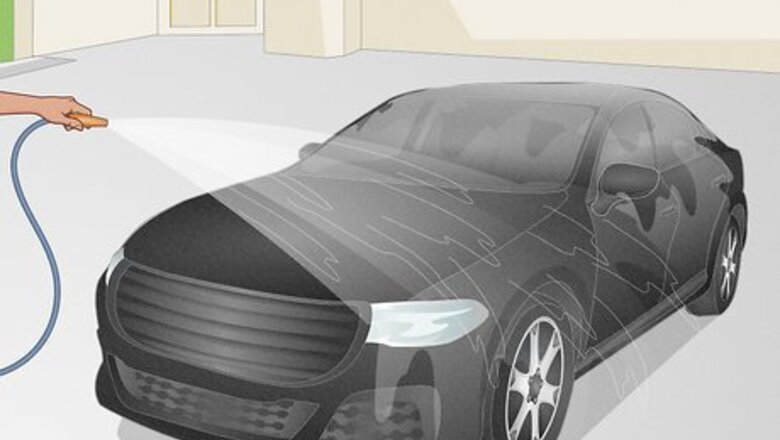
views
- Scrub leather or vinyl seats with toothpaste and a toothbrush, and spruce up leather with equal parts vinegar and linseed oil.
- Use baking soda to clean or freshen up your car: combine it with water to scrub stains away, or just leave a cup of baking soda in your car to absorb odors.
- Spray your car’s interior hard surfaces with equal parts water and rubbing alcohol, and wipe the surfaces down with a clean microfiber cloth to prevent lint buildup.
Cleaning the Car Exterior
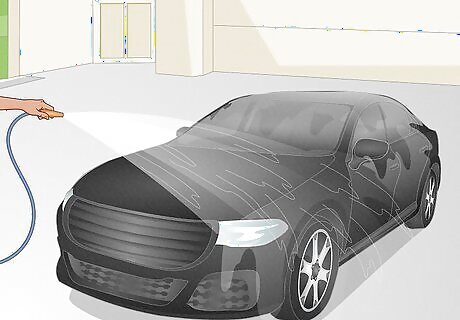
Rinse your car with a hose or bucket of water. Rinsing excess dirt off your car prior to cleaning it will make your job easier overall. Try to break loose any buildup and wipe down the entire surface of the car with a sponge or microfiber rag. Be careful not to scrape any loose dirt or pebbles across your car with the sponge or rag, as this can damage your paint job.
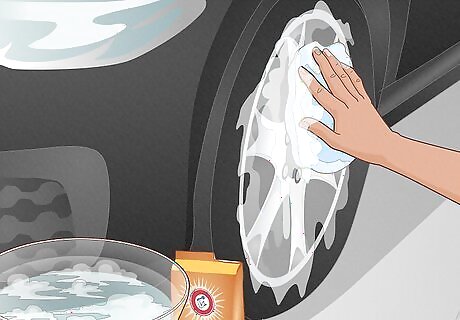
Clean salt and grime off your car with baking soda and soapy water. Add 1 cup (240 mL) of baking soda to 1 gallon (3.8 L) of soapy hot water to make a powerful cutting agent. This can be especially effective during or after the winter, when your car is likely to build up a lot of salt. Baking soda is also great for scrubbing rust from your car’s hubcaps. Mix 3 parts baking soda with 1 part warm water to form a thick paste. Apply the paste to the hubcaps and leave it there for a few minutes before wiping it away with a rag.
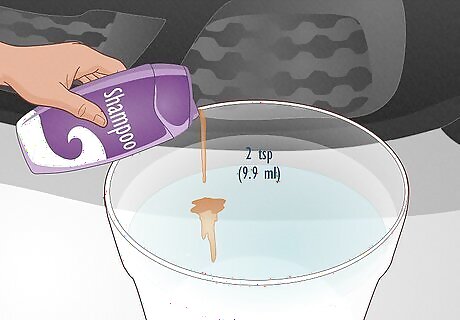
Wash your car with 2 teaspoons (9.9 mL) of shampoo and water. Shampoo is a great household cleanser you can use to cut grease and grime on the body of your car. Just mix 2 teaspoons (9.9 mL) of shampoo into a 2 gallon (7.6 L) bucket of water. Make sure that you scrub with a soft microfiber cloth so you don't scratch your car's paint. Be sure not to use too much shampoo, as undiluted cleaners can also damage your car's paint job. Baby shampoo is ideal, as its gentle ingredients won't harm your car's paint. Make sure your bucket has a dirt trap. A dirt trap will prevent dirt from clinging onto the rag and ending up back in the car. Use a clean dust mop to reach difficult places, such as the roof or hood of the car.
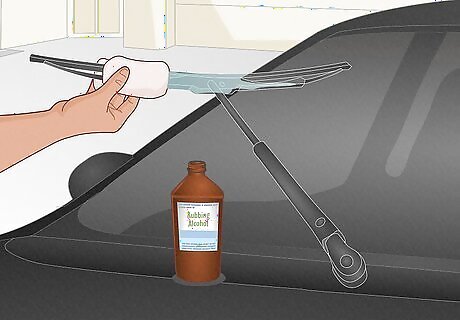
Clean road grime off windshield wipers with rubbing alcohol. Wet a rag with rubbing alcohol so that it’s damp but not dripping. Then take a wiper blade in hand, and firmly pull the rag along the rubber edge of the wiper blade to remove dirt and grime.
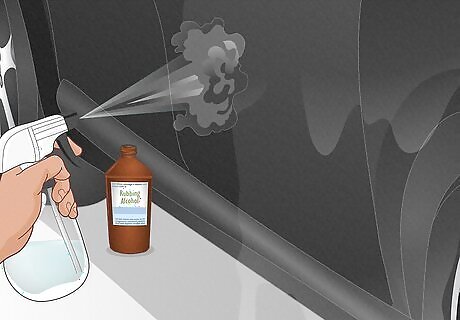
Remove tree sap with a denatured alcohol-water mixture. Denatured alcohol dissipates tar and sap well. After you’ve washed the rest of your car, mix equal amounts of rubbing alcohol and room-temperature water in a spray bottle and spray a generous amount over the affected area of your car. Let it sit for 1 or 2 minutes and then wipe it off with a cloth. This may take a few attempts before you completely remove the sap. Don’t have rubbing alcohol? Try peanut butter. Dab a thin film of peanut butter onto the affected area of your car and allow it to sit for about a minute before wiping it off.
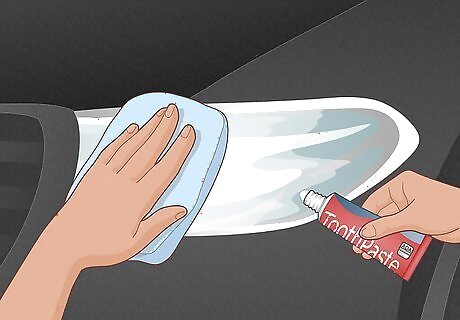
Scrub foggy headlights with toothpaste. If your car's headlights are getting a bit smudgy or grimy, rinse them clean of loose dirt and debris. Then apply any cheap toothpaste to them and rub them clear with a damp microfiber towel. Be sure not to get any toothpaste on your car's paint job, as it could damage the paint.
Cleaning Hard Surfaces Inside the Car
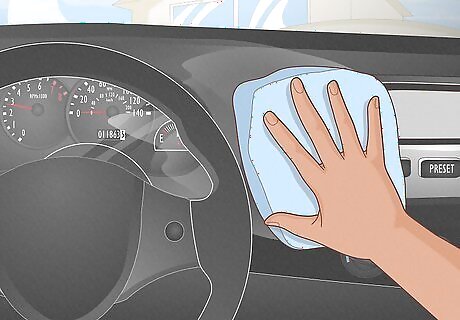
Wipe all surfaces clean with a water-dampened rag. Run a clean rag or sponge under warm water so that it’s wet, but not dripping. Wipe down all the hard surfaces on the inside of your car prior to washing them. This will remove excess grunge from the surfaces of your car and prevent you from spreading dirt to your seats or floor.
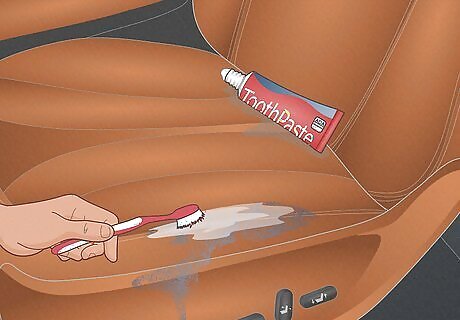
Scrub stains on leather or vinyl with toothpaste and a toothbrush. Apply a thin layer of non-gel white toothpaste to stains on any vinyl or leather surfaces inside your car. Then, take a new toothbrush and scrub at the stains for about a minute. Wipe away the toothpaste with a damp microfiber rag or paper towel, and repeat as necessary until the stain fades. Always test your cleaner on a small area first. There is a chance that the dye can be affected by the cleaning agent. Swap in rubbing alcohol if toothpaste fails. Lightly dab your stain after you've tested the alcohol on the surface you will be cleaning. The more alcohol you use, the harsher the solution will be, and the more likely it will bleach whatever color your car might be dyed.
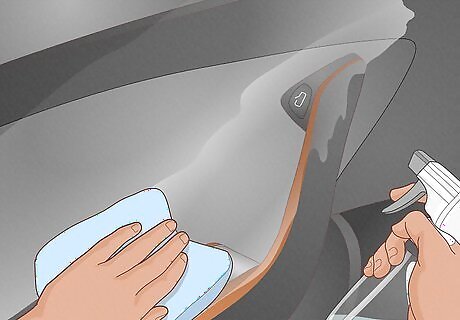
Wipe down plastic surfaces with equal parts water and rubbing alcohol. Add room temperature water and isopropyl alcohol to a spray bottle in a 1-1 ratio. Spray this mixture on hard surfaces and then wipe them with clean microfiber cloths. Tip: if you don't have microfiber cloths, try used fabric softener sheets. Not only will you save a clean rag or paper towel, but fabric softener sheets won’t leave lint behind like some rags and paper towels may.
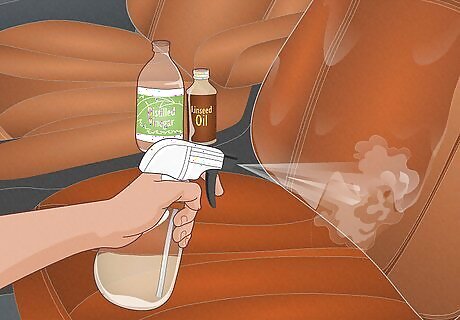
Spruce up leather surfaces with equal parts vinegar and linseed oil. If you’ve got leather seats, a mixture of vinegar and linseed oil will help you beat dirt and grime. The shine it leaves behind is an added bonus! Simply combine the vinegar and oil in a spray bottle and spray your leather surfaces, then wipe the surfaces dry with a clean, dry rag or paper towel.
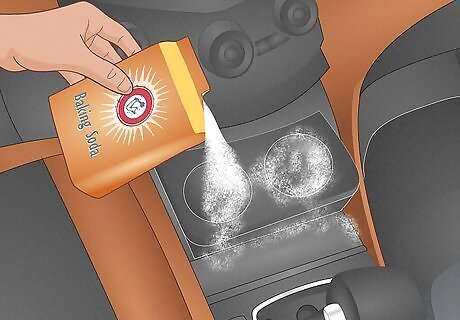
Sprinkle some baking soda in your cup holder or ashtray to purify the air. About 2 teaspoon (9.9 mL) of baking soda can absorb the smells and odors in your car. Whether you smoke or not, baking soda in your ashtray or cupholders will act as an air purifier. It may take a few days to notice the difference in air quality, but once you car’s interior smells fresher, wipe away the baking soda with a damp cloth. If you don’t want to fill your car’s ashtray or cupholders with baking soda, you can fill a mug or cup and leave it in the cupholder instead. For additional zest, add a couple of drops of your favorite essential oil to the baking soda. Lavender, eucalyptus, and lemon are all popular fresh scents.
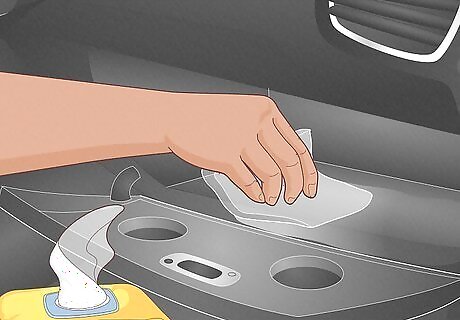
Wipe down the glove compartment with baby wipes. Clear out any garbage or dust that might have accumulated there. Often, forgotten items, like snacks, spoil in glove compartments and make your car seem less clean than it actually is.
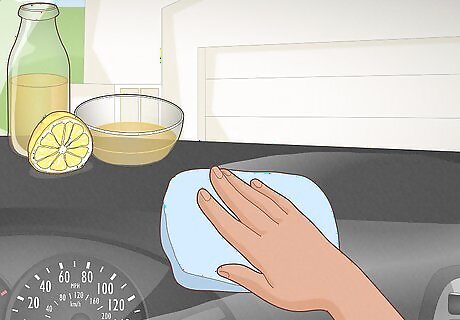
Mix lemon juice with olive oil and apply it to hard surfaces as a protectant. Combine 1 part fresh lemon juice with 2 parts olive oil in a bowl. Dab a small amount on a clean rag or paper towel, then rub the solution over any vinyl or hard surfaces inside your car, including the dashboard, to give them an extra sheen. Do not apply this solution to pedals, levers, or anything you need to drive. This protectant leaves behind a smooth seal that you could slip on while operating your vehicle.
Cleaning Fabric Inside the Car
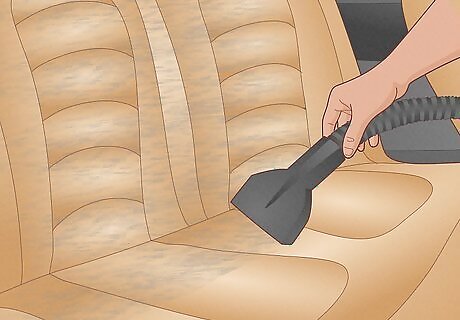
Vacuum any fabric inside your car thoroughly before deep-cleaning. Prior to deep-cleaning, run a vacuum over any fabric surfaces in the car. Failing to do this can make it more difficult to deep-clean; sweeping up loose crumbs and dirt will prevent you from rubbing them into the fabric later. If you have hair that the vacuum won't pick up (including pet hair), try running a pumice stone over the fabric. Swipe the stone in one direction to loosen the hair, then swipe it back again to pick the hair up.
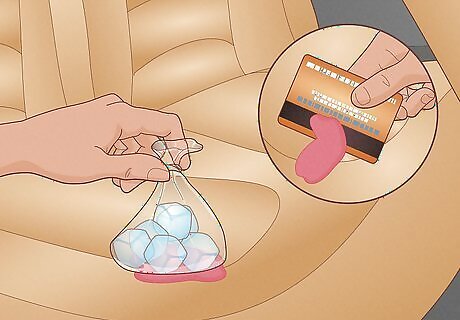
Remove gum with ice cubes. If you've got gum stuck to any surface in your car, cooling the gum down will help it solidify and make it easier to scrape off with a credit card or a dull knife. Put a handful of ice cubes in a plastic baggie to prevent any potential moisture issues from occurring, then apply the baggie to the gum and wait for it to freeze, about 20 minutes. Freezing the gum will make it easier to remove it in large chunks. If any small pieces are still left behind, scrub them with a toothbrush to loosen them, then vacuum them up. If you don't want to use ice cubes, you can also use a freezer pack.
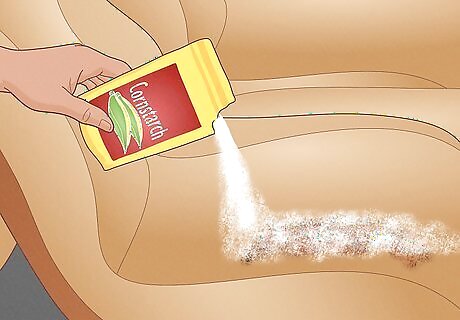
Pick up grease stains with cornstarch. Sprinkle grease stains with cornstarch and set a timer for 30 minutes. The cornstarch will absorb the grease, causing the stain to fade. When the timer goes off, vacuum the cornstarch and check the condition of the stain. If the stain still hasn’t faded, you may need to repeat the process. Some experts recommend using a little water with the cornstarch to make a paste. Allow the paste to dry, then brush away the powder and grease.
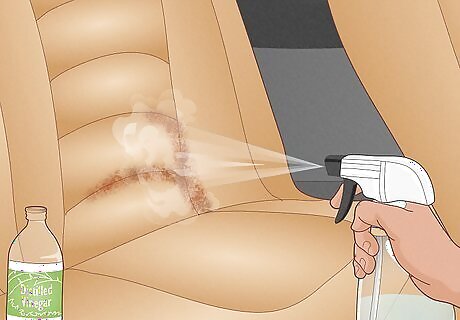
Spray a mix of equal parts vinegar and water on other stains. Mix equal parts vinegar and water in a spray bottle. Apply your mixture to mild non-grease stains and let it soak in for a few seconds before blotting it with a dry paper towel or rag. Many stains will disappear simply by spraying the vinegar-water mixture onto it and wiping it away. But other stains are peskier and may need to be scrubbed with a paper towel or rag.
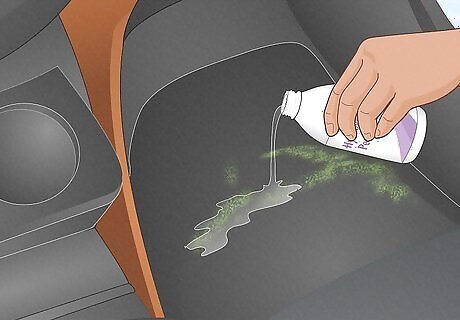
Blast grass stains with hydrogen peroxide. Dab a 3% solution of hydrogen peroxide to a grass stain and let it soak into the stain for a few seconds. Then soak up the peroxide with a dry paper towel. If you can't find hydrogen peroxide, pre-treat your stain with equal parts white vinegar, rubbing alcohol, and warm water. Rub the mixture directly on the stain and then wash as normal.
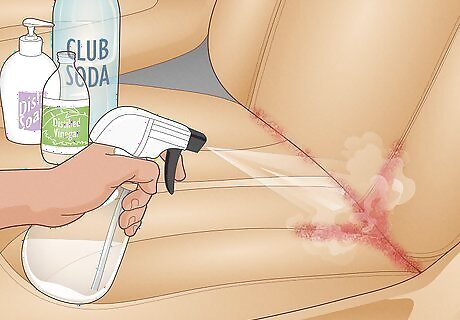
Apply dish soap, vinegar, and club soda to the toughest stains. In a spray bottle, mix equal parts dish soap, white vinegar, and club soda. Spray this solution liberally onto your car’s toughest fabric stains, and then scrub the stains with a scrub brush to lift and remove them. Dip a clean rag in warm water and apply it to the affected spot to rinse the mixture out of the fabric.
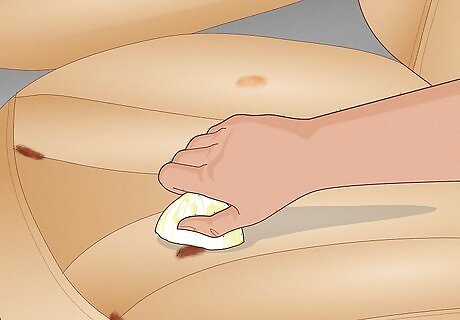
Soften scorch marks with juice from a raw onion. This works great for burn marks left by cigarettes. Hold a cut onion to the burn, and after you notice that the juice of the onion has been absorbed into the fabric, soak the stain in water to pick up the onion juice. Wipe the water and onion juice away with a dry rag or paper towel.
Improving Car Air Quality
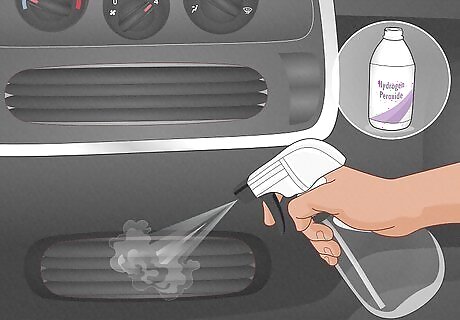
Spray a water-peroxide mix into your car’s fresh-air intake and run the fans. Combine 1 cup (236.6 mL) of water and 1 tablespoon (14.8 mL) of hydrogen peroxide in a spray bottle and shake the solution gently but thoroughly to mix. Then spray it into the fresh-air intake in your car and turn the fans on full-blast. This spray will kill germs and mold living in your car, but it's a gentler cleaning agent than most and will not irritate your lungs or eyes.
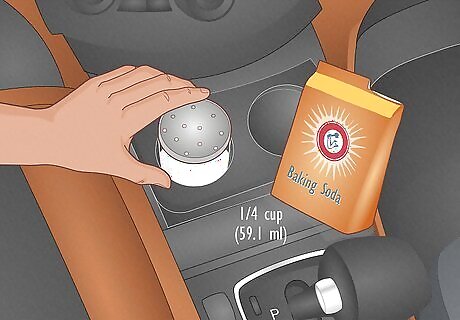
Fill a jar with ⁄4 cup (59.1 mL) of baking soda to use as an air freshener. Add ⁄4 cup (59.1 mL) of baking soda to a small jar and punch a few holes into the lid to allow for air flow. Put it in a cup holder or out of sight in a pocket. Add a few drops of essential oils to create a pleasant fragrance to accompany the refreshing effects of your baking soda. Alternatively, add the baking soda to a cup or some other container and stretch some cheesecloth across the top, and poke a few holes in the cheesecloth.
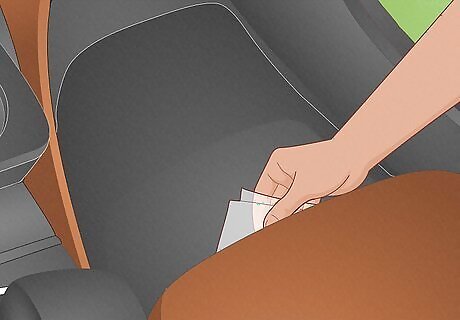
Hide dryer sheets under seats, floor mats, and in pockets. These will help your car fight persistent odors. If you participate in sports or a physical activity, tuck a dryer sheet in your trunk or in an interior pocket to fight strong, sports-related odors.
Cleaning Car Windows
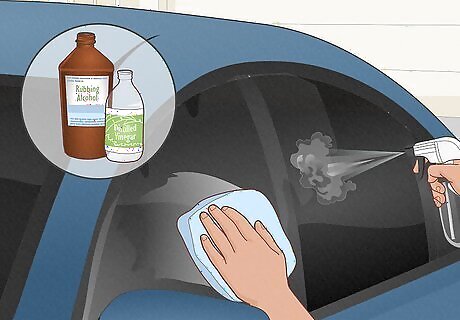
Clean your windows with a water-vinegar-alcohol mix and a microfiber cloth. Add 1 cup (236.6 mL) of water, ⁄2 cup (118.3 mL) of vinegar, and ⁄4 cup (59.1 mL) of isopropyl alcohol to a spray bottle to make homemade window cleaner. Gently shake the solution to mix it. Spray it onto the interior and exterior windows of the car, then wipe the glass with a clean microfiber cloth. Don't have rubbing alcohol? Vinegar and water may also work alone. Paper towels will also clean your windows effectively, but they may cause more streaking than a microfiber cloth and leave lint behind. Wipe windows clean from top to bottom. This will prevent you from having to clean up drip marks or trails. Using a different wiping direction between interior and exterior can help reveal any spots you've missed. For especially dirty windows, use 2 rags, one for wiping away grime, and the other for finishing and drying excess.
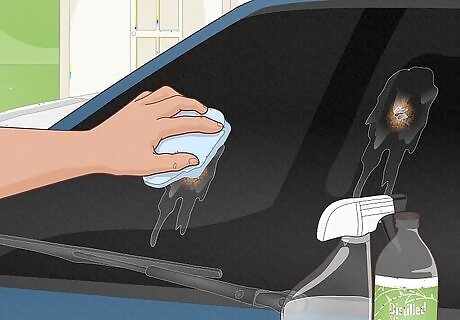
Remove stubborn bug splatter with undiluted vinegar. Spray your car window or windshield with vinegar and simply wipe it clean. If your bug stain is especially bad, allow the vinegar to soak into the stain before wiping it away. Seltzer water has also been reported to loosen insects stuck to your car, after you allow it to soak for few minutes.
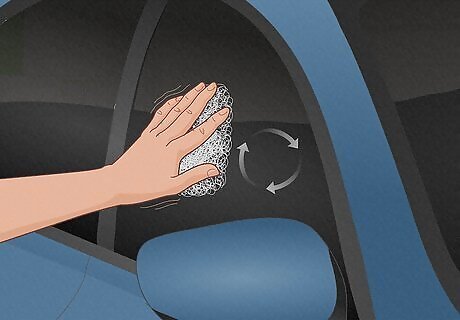
Use 0000-grade steel wool to remove stubborn watermarks. Gently rub the windshield and windows with the steel wool in a circular movement. Then wipe down the windows once more with your cleaner, and allow them to dry.




















Comments
0 comment